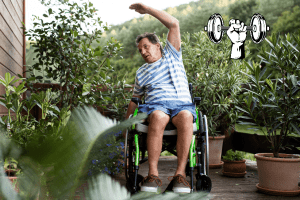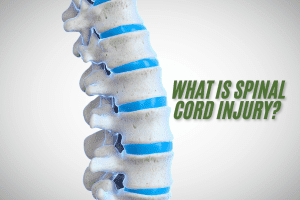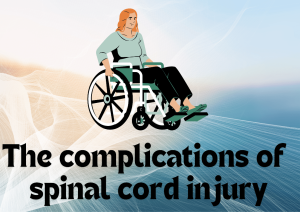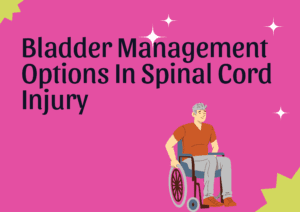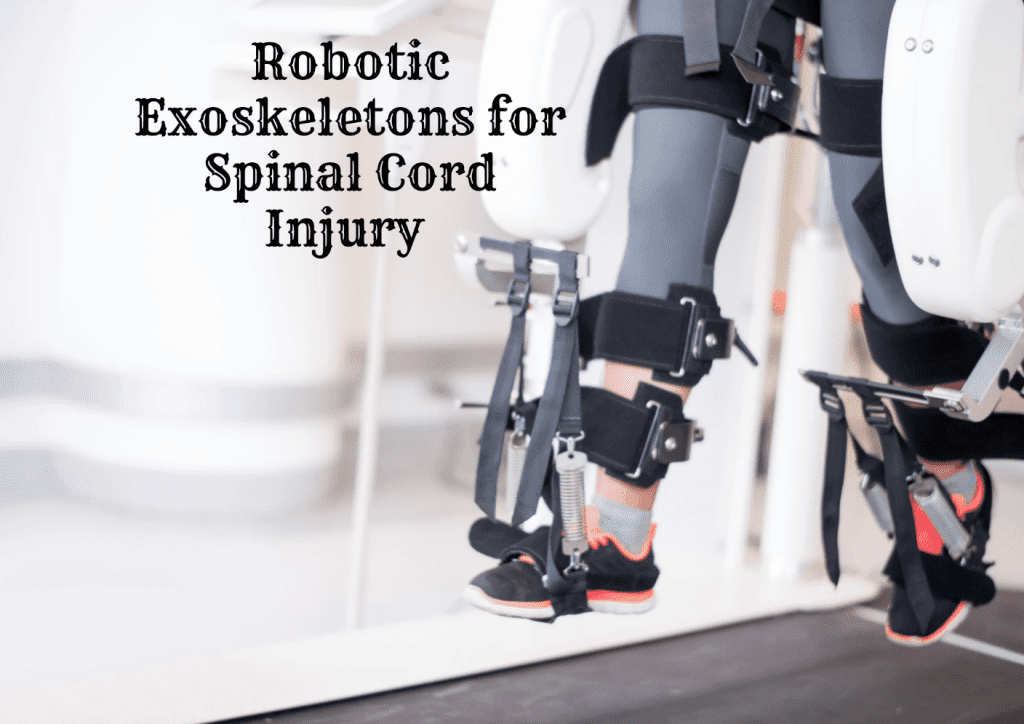
By Scihealthhub – September 23, 2024
Robotic exoskeletons provide individuals with spinal cord injury new hope by enhancing mobility, promoting greater independence, and improving their overall quality of life.
Spinal cord injury (SCI) is a serious and incapacitating condition where damage to the spinal cord results in disruption of nerve signals, causing loss of movement, loss of sensation and impairment of other body functions below the injury site.
Improving mobility is one of the cardinal goals of treatments for spinal cord injury as it helps enhance independence and reduce the risk of some secondary complications of spinal cord injury.
With improved mobility, individuals with spinal cord injury can move and perform their normal daily activities despite their physical limitations.
In recognition of these facts, scientists have done enormous work exploring ways of achieving mobility improvements in spinal cord injury.
While technologies like stem cells therapy, gene therapy and growth-promoting factors holds great future potentials, they are still in the experimental stages.
Consequently, rehabilitation therapy stands as the current cornerstone therapy and the most effective treatment approach for achieving mobility improvements in spinal cord injury.
Traditional rehabilitation methods focus on physical therapy to maintain muscle strength and prevent secondary complications, but they rarely restore significant motor function.
However, the advent of robotic exoskeletons offers new hope for individuals with spinal cord injury, potentially transforming rehabilitation outcomes and enhancing independence.
What Are Robotic Exoskeletons?
Robotic exoskeletons are wearable devices that support and enhance human movement.
They consist of an external frame that fits over the user’s body and motors or actuators that assist or mimic natural movement patterns.
Initially developed for military and industrial applications, robotic exoskeletons have rapidly evolved for use in medical rehabilitation, particularly for individuals with spinal cord injury.
How Do Robotic Exoskeletons Work?
Robotic exoskeletons are designed to assist with walking and standing, enabling individuals with spinal cord injuries to engage in physical activities that would otherwise be impossible.
These devices are typically controlled by a combination of sensors and software algorithms. The sensors detect the user’s movements or intentions, such as shifting weight or attempting to move a limb, and the exoskeleton responds by providing the necessary mechanical support or movement.
In some advanced models, brain-computer interfaces (BCIs) are integrated, allowing users to control the exoskeleton with their thoughts. This technology is still in its early stages but represents a significant leap forward in making these devices more intuitive and effective.
Key Benefits of Robotic Exoskeletons for Spinal Cord Injury Individuals
Improved Mobility: The most apparent benefit of exoskeletons is the ability to stand and walk again. Even if the movement is assisted, the psychological and emotional benefits of being upright and mobile are profound.
Reducing the risk of secondary complications: Regular use of an exoskeleton can help prevent the secondary complications associated with spinal cord injury, such as pressure sores, muscle atrophy, and osteoporosis. It also promotes cardiovascular health, aids in maintaining bone density and help to reduce pain.
Neuroplasticity and recovery: There is growing evidence that repetitive, task-specific movements facilitated by exoskeletons can promote neuroplasticity—which is the brain’s ability to reorganize itself by forming new neural connections. This could potentially lead to improved motor function over time.
Independence and quality of life: By enhancing mobility, exoskeletons can increase an individual’s independence, allowing them to participate more fully in daily activities and social interactions. This boost in autonomy can significantly improve the quality of life.
Psychological benefits: the excitement of making eye contact and walking with assistance can result in improved mood and a renewed sense of hope for the future.
Challenges and Limitations of Robotics Exoskeleton Use
While the potential benefits are immense, the adoption of robotic exoskeletons in spinal cord injury rehabilitation is not without challenges.
Cost and affordability: these devices are expensive, and many people may not have access to them due to financial constraints. For instance, ReWalk is reported to cost close to $70,000.
Limited flexibility: users may find it difficult maneuvering in confined spaces due to the substantial space required to stop and turn. Also, they may not adapt well to uneven surfaces.
Weight and bulkiness: exoskeletons can be heavy and cumbersome making them less comfortable to wear.
Power supply and battery life: most of these devices have a limited battery life (2-8 hours) which can restrict usage. Also, recharging can take several hours.
User selection: not all individuals with spinal cord injury are suitable for current robotic exoskeletons use. Instead, the devices are designed to accommodate specific users based on factors such as the level and severity of the injury and body size and weight of the individual.
Over-reliance on technology: may cause individuals or therapists to neglect traditional rehabilitation methods that focus on improving natural muscle strength, flexibility, and balance. As a result, some experts argue that exoskeletons should complement, not replace, traditional rehabilitation methods.
Technology limitations and breakdowns: Exoskeletons are complex machines that require maintenance and can break down.
Psychological impact: the use of exoskeletons can have varying psychological impacts on individuals. While some people may find them empowering, others may experience emotional problems like loss of confidence, anxiety and stress.
Top Robotic Exoskeleton Manufacturers for Spinal Cord Injury Rehabilitation
Here are some of the top robotic exoskeleton manufacturers:
ReWalk Robotics
ReWalk Robotics is a leading name in exoskeleton technology, particularly for personal use by individuals with spinal cord injury.
The ReWalk Personal System is the most well-known product, enabling users with paraplegia to stand, walk, and even climb stairs with the help of crutches or a walker.
In late 2012, the ReWalk Personal System obtained CE certification. In June 2014, it became the first robotic exoskeleton approved by the U.S. Food and Drug Administration (FDA) for use in the home and in the community.
With research-backed effectiveness, ReWalk has become a symbol of hope for many in the spinal cord injury community,
Ekso Bionics
Ekso Bionics is a pioneering company in the field of exoskeletons, having developed one of the first wearable robots for rehabilitation.
The Ekso series, developed by Ekso Bionics, Inc. in the United States, consists of the Ekso GT and Ekso NR medical lower extremity exoskeletons.
Their flagship product, EksoNR exoskeleton, received FDA approval in April 2016 for use in neurorehabilitation settings for gait training and rehabilitation of individuals with spinal cord injury and stroke.
It allows patients to stand and walk with assistance, promoting both physical rehabilitation and improved mental well-being.
Parker Hannifin (Indego)
Indego is the result of the joint work of Vanderbilt University and Parker Hannin, Inc. The device obtained FDA approval in 2016 for use in individuals with spinal cord injuries, allowing them to walk again with assistance.
The Indego exoskeleton robot has a lightweight and portable design that facilitates easy donning, doffing, transportation, and storage.
Indego is used in rehabilitation settings to improve gait training and physical therapy outcomes, but it can also be worn by individuals at home or in their daily activities, fostering greater independence and quality of life.
Cyberdyne (HAL – Hybrid Assistive Limb)
Cyberdyne’s HAL (Hybrid Assistive Limb) was developed by the Japanese robot maker, Cyberdyne Corporation. It obtained International Organization for Standardization and CE certification in 2013 and 2018, respectively. It also received FDA certification in the United States.
HAL is unique in the exoskeleton industry due to its reliance on bioelectric signal detection to move. It detects faint signals from the wearer’s muscles and nerves, allowing for smoother and more natural movements compared to some other systems.
HAL has been particularly praised for its application in both rehabilitation settings and long-term mobility assistance. Its clinical use has been shown to enhance rehabilitation outcomes for people with spinal cord injuries by promoting neuroplasticity, potentially leading to improved motor function over time.
SuitX (Phoenix Exoskeleton)
SuitX, a relatively newer player in the exoskeleton industry, has made waves with its Phoenix Exoskeleton. This lightweight exoskeleton, designed for ease of use, provides mobility solutions for those with spinal cord injuries.
Weighing less than 30 pounds, Phoenix is one of the lightest exoskeletons on the market and offers a cost-effective solution for individuals looking for a personal mobility device. The modular design allows for adjustments to suit different user needs and makes it easy to take on and off.
The Future of Robotic Exoskeletons in Spinal Cord Injury Rehabilitation
The future of robotic exoskeletons in spinal cord injury rehabilitation is promising. As technology continues to advance, these devices are likely to become more affordable, more user-friendly, and more effective.
Research is ongoing into more adaptive and personalized exoskeleton systems that can cater to a wider range of injuries and user needs.
Moreover, as our understanding of neuroplasticity and brain-machine interfaces deepens, the integration of these technologies with exoskeletons could lead to breakthroughs that were once thought impossible.
In the not-too-distant future, exoskeletons might not only assist with movement but might also help with restoration of lost functions, offering individuals living with spinal cord injury a real chance at regaining independence.
In conclusion, from enhancing mobility and independence to improving physical and psychological well-being, robotic exoskeletons is an evolving technology that is transforming the rehabilitation process for individuals with spinal cord injury.
If you enjoyed this article, please press the subscribe button and follow our social media handles. Feel free to drop your comments or questions.

